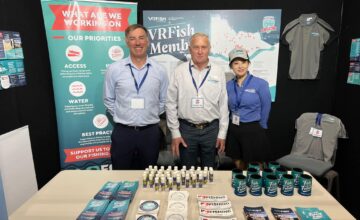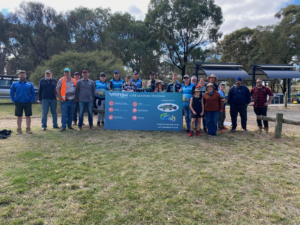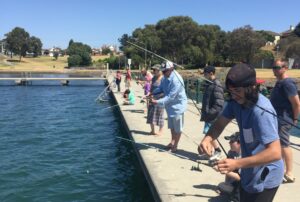July 6, 2017
Written by Franz Grasser, VRFish Board member
During the snapper seasons of 2011 and 2012, there were a number of reported instances of dead and dying snapper floating on the surface in the Port Phillip and Westernport Bays. Clearly mortality snapper rates released by recreational fishers was a key part of the problem. Subsequently, VRFish decided to find a way to implement an information and education campaign that would increase released snapper survival.
In 2013, a grant for just under $40,000 from the Recreational Fisheries License fund was approved, and work commenced on the planning of a campaign to roll-out, ahead of and, during the 2014 snapper season. Right from the outset, the concept of this project resonated with anglers and the initiative was supported by a range of stakeholders.
This support was to have profound positive effects throughout the project. While the initial plan was limited advertising in fishing related media, the scope of this advertising, eventually, more than doubled due to the fact that media partners and suppliers provided significantly discounted costs as well as voluntary inputs at no cost. Similarly other suppliers such as printers of the stickers, brochures and posters offered significantly reduced costs which, in turn, led to the ability to divert these savings into the increased exposure of the campaign.
Furthermore, professional advice and intellectual property was freely given by a range of stakeholders at either no cost or mates’ rates. Notable communication advice came from: Marc Ainsworth of Fisheries Victoria; snapper science from Paul Hamer at Fisheries Victoria; veterinary science from Paul Hardy-Smith and; images and footage by Alistair McGlashan. There were also significant volunteer and mates’ rates contributions from a range of other stakeholders which offered many tangible inputs. These included; boats by Matt Boulton of Fish On Charters; Trevor Hogan of Launching Way and; a snapper filming cage by Lawrence Moore.
Many others supported the project, but there are too many to list here, including other members of VRFish and VRFish staff and members of various fishing clubs etc. We also obtained great support from Fishing Tackle Stores. Point-of-sale posters, brochures and stickers were embraced by dozens of tackle stores who helped to spread the message and, in some cases, still do.
We were also able to promote the campaign at numerous events and the striking design and images used in the campaign ensured that it captured the attention of attendees and visitors. The project also used many forms of electronic and social media to extend distribution of the message to snapper fishers. This included; websites, emails, e newsletters, Facebook and YouTube.
The money saved due to the high level of volunteer input towards the project meant that it was possible to continue the campaign, not just for the 2014 snapper season but also, for the 2015 season and beyond. This means that the reach obtained in making snapper fishers aware of the techniques that improve released snapper survival was higher by many multiples than what was originally planned.
The campaign was not just about quantity but also quality. The skills of the participants and suppliers and the quality of images available led to the design and implementation of quality messaging and media. When the Australian Recreational Fishing Foundation (ARFF) was developing a new recreational fishing code of practice, they employed as a consultant Adam Smith of Ecologic who conducted a literature search and review of relevant codes of practice from around the world. In this review the snapper survival project was raised as a positive example of the way that messaging needs to be developed to be adopted by fishers.
Finally, and most importantly, what has been the result of the campaign? The overall result has been positive because in the snapper seasons since the initial roll-out of the campaign, in 2014, there have been no reports of dead or dying snapper floating in the areas observed in earlier years. While it is not possible to be certain that this outcome is a direct result of the snapper survival project, it is highly probable that the campaign contributed significantly to the result.
It is also notable that many snapper fishers have modified their approach to fishing since the project began. Greater use of lures and circle hooks, as well as improved fish handling and awareness of barotrauma, are being observed and this is something that the project participants can be proud of.








